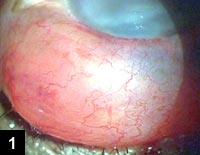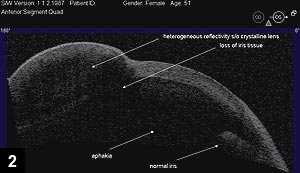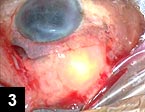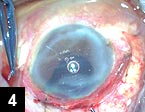Anterior segment OCT used to diagnose a case of phacocele
Because there was no capsular support, a posterior chamber IOL was implanted using a fibrin glue-assisted technique.
 Amar Agarwal |
Post-traumatic dis-location of the crystalline lens into the subconjunctival space, or phacocele, is a rare entity. A phacocele can masquerade as an occult scleral perforation with uveal prolapse. This can be diagnosed with the help of high-resolution anterior segment optical coherence tomography. The problem comes in managing such a case as there is no capsular support present.
Introduction
A 50-year-old woman was referred to us with sudden diminution of vision after blunt trauma with a clenched fist 3 days prior. Slit lamp examination revealed chemosis and superonasal conjunctival swelling with grayish discoloration along with aphakia and a superior iris defect (Figure 1). A clinical diagnosis of occult scleral perforation with uveal prolapse and dislocation of the crystalline lens was made. However, indirect ophthalmoscopy and posterior segment ultrasound could not localize the lens. Anterior segment OCT (Carl Zeiss Meditec) localized a heterogeneous reflecting body in the area of the swelling, suggesting a possible phacocele (Figure 2).
Surgical management

The conjunctiva was first opened up. On exploration, the lens was found in the superonasal subconjunctival space (Figure 3). The lens was removed with the help of a vectis. The scleral laceration was explored and sutured. Subsequently, bimanual vitrectomy was done. There was no capsular support present. In such cases, the alternatives of lens implantation are either an anterior chamber IOL or a scleral-fixated IOL with sutures. We decided to implant a 6.5-mm PMMA posterior chamber glued IOL (Figure 4).
Procedure
Two partial thickness limbal-based scleral flaps about 3 mm by 3 mm were created exactly 180° diagonally apart and about 1.5 mm from the limbus. This was followed by vitrectomy to remove all vitreous traction.
Two straight sclerotomies with an 18-gauge needle were made about 1.5 mm from the limbus under the existing scleral flaps. While the IOL was being introduced with the left hand of the surgeon using McPherson forceps, end-gripping microrhexis forceps (MicroSurgical Technology) were passed through the inferior sclerotomy. The tip of the leading haptic was then grasped with the microrhexis forceps, pulled through the inferior sclerotomy following the curve of the haptic and externalized under the inferior scleral flap. Similarly, the trailing haptic was also externalized through the superior sclerotomy under the scleral flap.
The haptic can bend and break if it is pulled in wrong direction or if it is not held in the tip. Hence, while externalizing, the haptic should be held exactly in the tip and pulled along the curve of the haptic. There is no exact length that has to be externalized. The entire haptic length that comes out depends upon the centration and size of IOL. Half of the length of the haptic brought outside gives good stability.
 | Phacocele. Note the subconjunctival swelling. The lens has been dislocated into the subconjunctival space. | ||
 Anterior segment OCT showing the phacocele. |
|||
| |||
With a 22-gauge needle, a scleral tunnel was made at the edge of the scleral flap. The tip of the haptic was then tucked in the tunnel in the same direction. This gave the IOL extra stability as the haptics were tucked in a scleral tunnel. Then, the reconstituted fibrin glue (Tisseel, Baxter) was injected under the superior and inferior scleral flaps. Local pressure was put on the flaps for about 10 to 20 seconds for the formation of fibrin polypeptides. The conjunctiva was also closed with the same fibrin glue. Postoperative monitoring of the anterior segment, subconjunctival area and IOL centration was done by anterior segment OCT and direct visualization.
Discussion
Anterior segment OCT is a non-contact investigative modality for assessment of the relations of the cornea, lens and the angle. Additionally, the subconjunctival potential space can be visualized with this method. OCT has been used to delineate structures in penetrating trauma. However, to the best of our knowledge, the use of this unique imaging modality for assessment of anterior segment structures in blunt trauma and in localization of an anteriorly dislocated crystalline lens has not been previously reported.
This patient was implanted with a glued IOL, and 3 weeks postop, vision was 20/20.
References:
- Agarwal A. Handbook of Ophthalmology. Thorofare, NJ: SLACK Incorporated; 2005.
- Agarwal A. Phaco Nightmares: Conquering Cataract Catastrophes. Thorofare, NJ: SLACK Incorporated; 2006.
- Agarwal S, Agarwal A, Agarwal A. Phacoemulsification – Two volume set. 3rd ed. Informa Healthcare; 2004.


